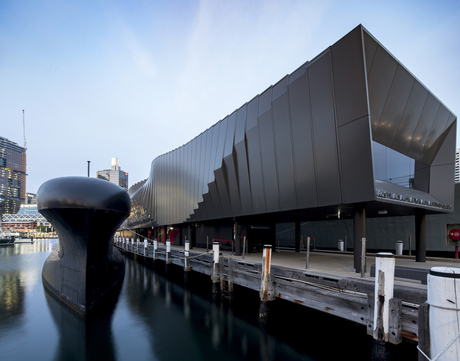Maritime Museum goes green

The Australian National Maritime Museum in Darling Harbour launched a new attraction, called Action Stations, in late 2015. The attraction features an immersive cinematic experience, a discovery and exploration space and audiovisual encounters that recall sailors’ memories on board the HMAS Advance, HMAS Vampire and HMAS Onslow.
The $12 million experience is housed inside a brand new building designed by award-winning studio Francis-Jones Morehen Thorp (FJMT). The building has been designed not only to be visually appealing and functional, but also to have minimal environmental impact through the incorporation of several sustainability features.
“Here at the Australian National Maritime Museum, we are passionate about the preservation and conservation of our marine environment, as well as the artefacts which tell the tales of the sea,” said the museum’s director and CEO, Kevin Sumption. “We wanted the building to reflect this ethos through the incorporation of sustainable design elements.”
The colour of the building — a dark, bottle-green-grey — complements the HMAS Onslow and HMAS Vampire and gives the impression that it changes colour through the day and with the change of weather. Due to the dark colour of the attraction, insulation and cooling were key aspects for consideration.

FJMT worked closely with building materials company Kingspan to ensure optimum insulation was achieved for the building, with minimal obstruction to the view of the vessels and Darling Harbour. The Kingspan panels feature an external and internal skin with an insulating layer between. Their in-built insulation has enabled efficient installation, delivering high thermal performance and lifetime insulation continuity.
As noted by FJMT Senior Associate James Perry, the design studio also had to consider “how best to integrate natural ventilation, given the building’s close proximity to the water”. So while certain areas of the building require air conditioning, such as the ticketing office and the projection rooms, there is no air conditioning in the main multiuse and exhibition space, where visitors enter and exit the HMAS Onslow and HMAS Vampire.
The exhibition space has a series of louvres and openings for natural ventilation and large overhead fans, which help to moderate the movement of air without impacting on the space itself. The design of the narrow but high exhibition space assists with air movement, as the height draws the warm air up. There is a concealed opening at the high point of the building that allows the air to exhaust.

The incorporation of natural ventilation systems is said to create a space that is more connected to its natural environment and to the vessels. Walking through the space, the visitor is able to view the maritime archaeological artefacts and marine-themed digital products at leisure, enjoying the sea breeze. While this design feature was implemented to enhance the sustainability of the attraction, it has also helped to create a complete sensory experience.
“What’s fascinating about this project is that each element has been strategically designed to emulate life at sea, while the sea has also influenced the design process, ultimately bringing the building to life,” said Sumption.
Dirty dancing across a new energy landscape
The real-time balancing of electricity generation (supply) and demand is like a dynamic dance and...
Digitising Australia's buildings is key to tackling net zero
Businesses around the world are continuing to focus on net zero, and building construction and...
Ausgrid steps closer to net zero using 'blue gas' switchgear
Ausgrid is using Siemens' blue gas insulated (GIS) medium-voltage switchgear, which uses...











